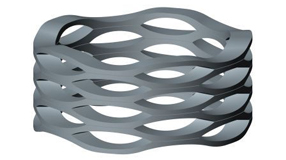Wave springs
Contents |
[edit] Introduction
Wave springs are some of the most widely used types of springs, but often, we don’t even realise that we are using them.
Most commonly found in circumstances where space is limited, wave springs are essential to many components in the world of mechanical design. They must be compact, provide ample force and be able to withstand immense pressure over a long period of time to be effective.
[edit] What are wave springs?
Wave springs are a type of compression spring made from flat wire. They are called wave springs as they have multiple waves per turn. The flat wire, along with multiple waves, combine to create the same amount of force at reduced work heights when compared with other types of springs.
With technological developments meaning that many devices that once used compression springs have shrunk in size, the need for smaller, more compact springs has grown. The reduced size has allowed engineers to reduce the spring cavity once common in many technologies.
Wave springs are designed bespoke dependent on a spring force vs. work height ratio.
[edit] How are wave springs made?
In a similar method to many other types of spring, flat wire is passed through a specially-calibrated machine where it coils and ‘bounces,’ resulting in a wave spring. The machine is set up to process the wire up to a certain length, providing a system that can be tailored to any given project or requirement, and reducing waste.
Whilst wave springs can be made from a variety of materials, including carbon and stainless steel, they require fewer materials to compose, resulting in more cost-effective production.
[edit] Properties of wave springs
Wave springs are versatile; they hold many advantages that maintain their popularity with designers. For example, where space is limited, the innovative design of the wave spring ensures that the same amount of force as a compression spring is produced at 50% of the operating height.
Due to the layered design, only one spring is needed, whereas with alternative springs, such as stacked disc springs, several are needed to provide the same effect. In addition, the design of the spring can be amended to reflect whatever the task requires. For example, factors such as wire size, wire form and the turn configuration can all be altered to ensure that the end result is fit for purpose.
[edit] Common uses of wave springs
Due to the fact that wave springs can be substituted for compression springs, they are regularly used in a number of daily item:
- Trainers
- Door locks
- Suspension systems
- Robotics
- Mechanical equipment
- Technological devices
- Medical products
- The oil and gas Industry
[edit] Related articles on Designing Buildings Wiki
- Compression springs.
- Die springs.
- E-spring.
- Flat springs.
- Key qualities of springs.
- Large and Hot Coiled Compression Springs
- Spring materials.
- Tension springs v torsion springs.
- The Difference Between Tension and Torsion Springs
- The importance of gas springs.
- The Multiple Uses of Compression Springs
- The Uses of Wire Forms Within the Construction Industry.
- Types of spring.
- Using springs in construction to prevent disaster.
Featured articles and news
A change to adoptive architecture
Effects of global weather warming on architectural detailing, material choice and human interaction.
How big is the problem and what can we do to mitigate the effects?
Overheating guidance and tools for building designers
A number of cool guides to help with the heat.
The UK's Modern Industrial Strategy: A 10 year plan
Previous consultation criticism, current key elements and general support with some persisting reservations.
Building Safety Regulator reforms
New roles, new staff and a new fast track service pave the way for a single construction regulator.
Architectural Technologist CPDs and Communications
CIAT CPD… and how you can do it!
Cooling centres and cool spaces
Managing extreme heat in cities by directing the public to places for heat stress relief and water sources.
Winter gardens: A brief history and warm variations
Extending the season with glass in different forms and terms.
Restoring Great Yarmouth's Winter Gardens
Transforming one of the least sustainable constructions imaginable.
Construction Skills Mission Board launch sector drive
Newly formed government and industry collaboration set strategy for recruiting an additional 100,000 construction workers a year.
New Architects Code comes into effect in September 2025
ARB Architects Code of Conduct and Practice available with ongoing consultation regarding guidance.
Welsh Skills Body (Medr) launches ambitious plan
The new skills body brings together funding and regulation of tertiary education and research for the devolved nation.
Paul Gandy FCIOB announced as next CIOB President
Former Tilbury Douglas CEO takes helm.
UK Infrastructure: A 10 Year Strategy. In brief with reactions
With the National Infrastructure and Service Transformation Authority (NISTA).
Ebenezer Howard: inventor of the garden city. Book review.
Airtightness Topic Guide BSRIA TG 27/2025
Explaining the basics of airtightness, what it is, why it's important, when it's required and how it's carried out.






















